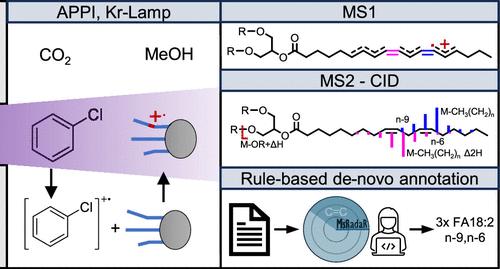用超临界流体色谱法从头解析酰基甘油的结构和碰撞诱导的缺电子前体离子解离
IF 6.7
1区 化学
Q1 CHEMISTRY, ANALYTICAL
引用次数: 0
摘要
描述了各种质谱脂质组学方法来解决双键(DB)位置,脂肪酸附着和sn位置,但需要专用仪器或化学衍生化。在这项研究中,我们证明了使用氯苯作为掺杂剂的掺杂剂辅助大气压光电离(dAPPI)产生酰基甘油的自由基阳离子(M+)和[M- h]+阳离子,称为缺电子前体离子(EDP)。观察到的[M- h]+离子是由M+的自由基氢提取而来的。离子。碰撞诱导的EDP离子解离允许基于规则的DB位置、脂肪酸附着和sn位置的重新注释。在33种标准甘油中,≥1 DB的标准甘油存在选择性电离,其中≤3 DB的标准甘油主要形成[M- h]+离子,≥4 M+的标准甘油主要形成[M- h]+离子。离子。EDP-CID生成了sn位置的片段峰特征强度比,以及由脂肪酸烷基链裂解引起的双键指示元素公式损失(EFL)的特征强度比,其强度在DB位置附近最大。通过以下EFL序列进行DB注释,例如M-CH3(CH2)n为第一个DB。对于每个丢失的DB,观察到Δ2H移位(M-CH3(CH2)n Δ2HDB-1),并将其用于后续DB的注释。在羟基或脂肪酸(M-FA-CH3(CH2)n)丢失后,观察到额外的片段序列,指示DB位置。MsRadaR是一个R软件包,可以通过EDP-CID光谱导航并可视化相关的EFL系列。最后,应用dAPPI-EDP-CID耦合的超临界流体色谱法对亚麻籽油中的57种酰基甘油进行了分析,对9种二甘油酯和24种甘油三酯进行了完整的DB位置表征。本文章由计算机程序翻译,如有差异,请以英文原文为准。

De Novo Structural Elucidation of Acylglycerols by Supercritical Fluid Chromatography and Collision-Induced Dissociation of Electron-Deficient Precursor Ions
Various mass-spectrometric lipidomics approaches are described to resolve double bond (DB) positions, fatty acid attachments, and sn-position but require dedicated instrumentation or chemical derivatization. In this study, we demonstrate that dopant-assisted atmospheric-pressure photoionization (dAPPI) using chlorobenzene as a dopant generates radical cations (M+.) and [M-H]+ cations of acylglycerols termed Electron Deficient Precursor Ions (EDP). Observed [M-H]+ ions are derived from radical hydrogen abstraction from M+. ions. Collision-induced dissociation of EDP ions allows rule-based de novo annotation of DB positions, fatty acid attachments, and sn-position. Among 33 acylglycerol standards, selective ionization for acylglycerols with ≥1 DB was observed, where acylglycerols with ≤3 DB formed mainly [M-H]+ ions and those with ≥4 M+. ions. EDP-CID generated characteristic intensity ratios of the fragment peaks for sn-positions and double-bond indicative elemental formula losses (EFL) originating from cleavages along the fatty acid alkyl chain with intensity maxima adjunct to DB positions. DB annotation was performed by following EFL series, such as M-CH3(CH2)n for the first DB. For each DB lost, a Δ2H shift is observed (M-CH3(CH2)n Δ2HDB-1) and used for the annotation of following DBs. Additional fragmentation series, indicative of DB positions, were observed after loss of hydroxyl groups or fatty acids (M-FA-CH3(CH2)n). MsRadaR, an R package, was developed allowing to navigate through EDP-CID spectra and visualize relevant EFL series. Last, supercritical fluid chromatography coupled to dAPPI-EDP-CID was applied for the analysis of 57 acylglycerols in linseed oil with complete DB position characterization of 9 diglycerides and 24 triglycerides.
求助全文
通过发布文献求助,成功后即可免费获取论文全文。
去求助
来源期刊

Analytical Chemistry
化学-分析化学
CiteScore
12.10
自引率
12.20%
发文量
1949
审稿时长
1.4 months
期刊介绍:
Analytical Chemistry, a peer-reviewed research journal, focuses on disseminating new and original knowledge across all branches of analytical chemistry. Fundamental articles may explore general principles of chemical measurement science and need not directly address existing or potential analytical methodology. They can be entirely theoretical or report experimental results. Contributions may cover various phases of analytical operations, including sampling, bioanalysis, electrochemistry, mass spectrometry, microscale and nanoscale systems, environmental analysis, separations, spectroscopy, chemical reactions and selectivity, instrumentation, imaging, surface analysis, and data processing. Papers discussing known analytical methods should present a significant, original application of the method, a notable improvement, or results on an important analyte.
 求助内容:
求助内容: 应助结果提醒方式:
应助结果提醒方式:


